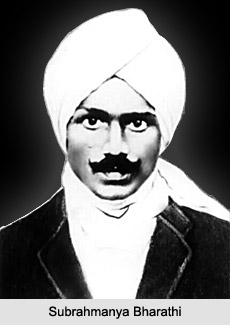 Poetry in twentieth century Tamil Literature developed through the innovations and works of a number of literary artists of the time. One of the most outstanding Tamil poets of the early twentieth century was Subrahmanya Bharati (1882-1921). He modernized and rejuvenated Tamil poetry by discarding the complex vocabulary and complicated sentence structure of his nineteenth-century predecessors and by preferring simple words and rhythms drawn from the everyday lives and activities of ordinary people in Tamil Nadu. He practiced this principle of simplicity in everything he wrote. Bharathi`s fame as a poet rests primarily on his numerous fiery songs of freedom-collected and published under the title Sarva Desa Geethangal (Songs for All Nations)-through which he sought to kindle the flames of patriotism and nationalism in the hearts of his fellow Tamilians. He is also celebrated for the novel ideas and techniques in his devotional (bhakti) lyrics to God.
Poetry in twentieth century Tamil Literature developed through the innovations and works of a number of literary artists of the time. One of the most outstanding Tamil poets of the early twentieth century was Subrahmanya Bharati (1882-1921). He modernized and rejuvenated Tamil poetry by discarding the complex vocabulary and complicated sentence structure of his nineteenth-century predecessors and by preferring simple words and rhythms drawn from the everyday lives and activities of ordinary people in Tamil Nadu. He practiced this principle of simplicity in everything he wrote. Bharathi`s fame as a poet rests primarily on his numerous fiery songs of freedom-collected and published under the title Sarva Desa Geethangal (Songs for All Nations)-through which he sought to kindle the flames of patriotism and nationalism in the hearts of his fellow Tamilians. He is also celebrated for the novel ideas and techniques in his devotional (bhakti) lyrics to God.
Another well known Tamil poet of the modern period is Kavimani Desika Vinayakam Pillai. His poems are full of breathtaking beauty, heart-warming love, and endearing, childlike simplicity. Most of his poems have been written for children and he started writing these as early as 1901. All these poems were collected and published by 1941 under the title Ham Thendral (Gentle Southern Breeze). Later, they became part of his collected poems, Malarum Malaiyum, which included all the mature poems he intended for adults as well. Eventually, his poems for children were republished in a separate volume called Kuzhandai Chelvam (Child`s Treasure) and won the government of Tamil Nadu`s Literary Award for children`s literature. Kavimani also had the rare ability to render foreign classics into Tamil so expertly that his translations read like original Tamil lyrics. His Asiya Jyothi and Vmar Khaiyam Padalgal were exact yet melodious renditions of Edwin Arnold`s The Light of Asia (a poetic depiction of the life of the Buddha) and The Rubiayyat of Omar Khayyam.
V. Ramalingam Pillai, also known as Namakkal Kavignar, was a renowned Nationalist poet of this period. He was the author of about 30 volumes of poetry and prose and he mostly wrote about the greatness of freedom and the liberation of the country, including such themes as the famous Salt march of Mahatma Gandhi in his Satyagraha (non violent, truthful aggression) against the British Raj. Apart from these passion-fired songs of patriotism, Namakkal Kavignar also composed a wonderful lyric called "Avanum Avalum" (He and She), which was extremely well received in his own day.
The poet Bharati Dasan wrote a number of fiery poems against the evils he saw in Tamil society, such as the divisive caste system, the ruthless exploitation of hardworking labourers, and the conflicts between the haves and the have-nots. At the same time, he experimented with a variety of literary forms and subjects. If his Pandiyan Parisu (Gift of the Pandiyan King) is a historical romance casting a nostalgic look at the glorious past of the Tamils, his Kudumba Vilakku (The Lamp of the Family) is a psychological masterpiece focused on the travails of family life in the average modern Tamilian household. His Azhagin Chirippu (The Smile of Beauty) captures the splendours of nature, while his Tamizh lyakkam (The Tamil Movement) is a poetic manifesto for the elevation of Tamil language and culture. Because of the socio-political-economic relevance of these themes and the captivating rhythms of his verses, Bharathi Dasan earned the title Pa Vendar (King of Poetry), and his poems sold in the millions all over Tamil Nadu.
Kanna Dasan was the first Tamil poet to gain immense fame by writing thousands of film songs, which remain popular to this day and are hummed by millions of Tamil-speaking people. It is noteworthy that, apart from his well-known film songs, Kanna Dasan wrote a number of poems with a literary flair. These poems have been collected in six parts under the title Kanna Dasan`s Poems. Also, he authored a small epic called Mangkani (Mango Fruit) and a long lyric on two star-crossed lovers called Attanaththi Adimandi.
New Poetry (puthuk kavithai) in Tamil literature emerged sometime around 1959. It refers to the woks of a group of young poets whose works were written sometime between 1959 and 1962. These works were collected in a volume called Puthuk Kuralkal (New Voices). The works of the new poets saw a radical break from earlier forms and themes and this group of poets experimented and innovated with the traditional styles of poetry writing. They also incorporated and took up a number of new issues into Tamil poetry which were more in keeping with the contemporary times.
Thus discussed above is the Modern Tamil Poetry as best exemplified in the works of the famous modern poets of the twentieth century.













